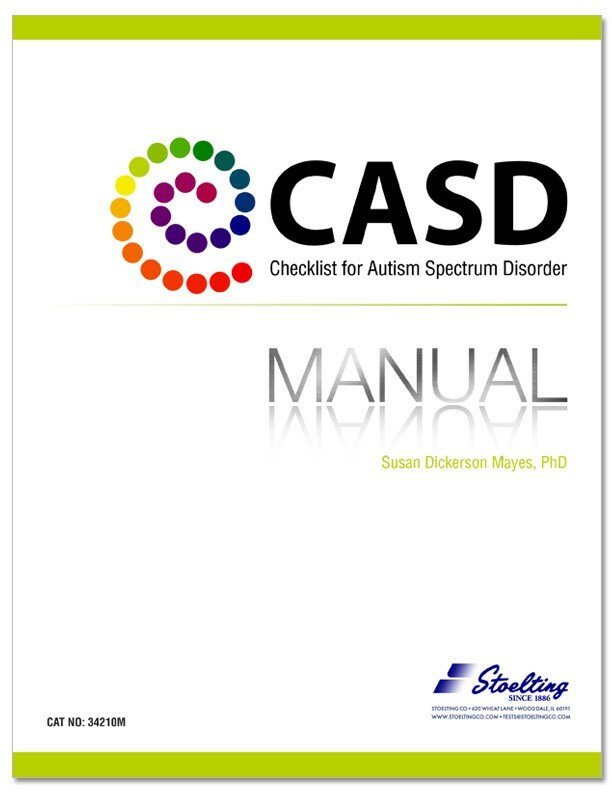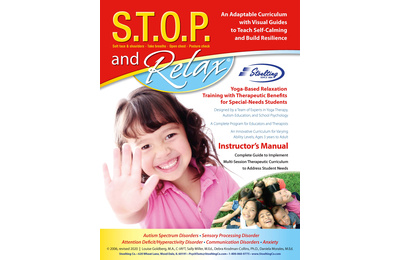Please specify the quantity of product(s).



Checklist for Autism Spectrum Disorder (CASD)
| Item | Product | Price | QTY |
|---|---|---|---|
| 34210 | Checklist for Autism Spectrum Disorder (CASD) | $150.00 | |
| 34210M | CASD Manual | $86.00 | |
| 34210R | CASD Record Forms, Pk/25 | $68.00 | |
| 34210-VD | CASD Training Video | $84.00 | |
| 34210-RE | CASD Record Forms-Spanish, Pk/25 | $65.00 |
The only published instrument consistent with the DSM-V recommendation that Autism is a single-spectrum disorder.
The only published instrument consistent with the DSM-5 recommendation that Autism is a single-spectrum disorder.
Susan D. Mayes, Ph. D.
- Age Range: 1-17 years
- Time to Administer: 15 minutes
- Qualification Level: B
The CASD offers a quick, valid means of screening for, and diagnosing, children with Autism, regardless of age, IQ or Autism severity. It consists of a comprehensive list of 30 symptoms of Autism, scored as present (either currently, or in the past) or absent, based on a semi-structured interview with the parent; information from the child’s teacher or child care provider; observations of the child, and other available records.
Studies show the CASD differentiates children with Autism from those with ADHD with 99.5 per cent accuracy, and from typical children with 100 per cent accuracy. It is equally effective in identifying children who have Autism and normal, or below normal, intelligence.
The CASD covers all core and associated symptoms of Autism.
The 30 CASD symptoms are grouped in six domains:
- Problems with social interaction
- Perseveration
- Somatosensory disturbance
- Atypical communication and development
- Mood and disturbance
- Problems with attention and safety
CASD Advantages
- Appropriate for all levels of intelligence
- Appropriate for toddlers through adolescence
- Simple and brief
- Provides information for diagnostic reports and treatment plans
- Clinically practical and cost-effective
- Useful for screening and diagnosis
- No extensive training required
- No test materials, software or scoring templates
Excellent Reliability and Validity
- Excellent congruence with DSM-IV-based clinical diagnoses
- 90% clinician/parent agreement
- High diagnostic agreement with other Autism instruments, including 98 percent with the Childhood Autism Rating Scale (CARS-page 46), and 93 percent with the Autism Diagnostic Interview-Revised (ADI-R-page 49).
The standardization sample included more than 1,000 children with Autism (1-17 years of age, IQs of 9-146), over 500 typical children, and children with other diagnostic groups (e.g., ADHD). All children in the Autism group had a total CASD score at, or above, the Autism cutoff of 15, which is the cutoff for both high- and low-functioning Autism. Scores of 10-14 are in the Pervasive Developmental Disorder-Not Otherwise Specified (PDD-NOS) range.
The CASD Kit (34210) includes the Manual and Interview Forms. Optional DVDs are available, demonstrating CASD administration, scoring and differential diagnosis with parents of children who have high-functioning and low-functioning Autism, Anxiety and ADHD with Behavior Problems.
CASD Training Video Sample- Interview
Literature Review
Falkmer, T., Anderson, K., Falkmer, M., & Horlin, C. (2013). Diagnostic procedures in autism spectrum disorders: A systematic literature review. European Child & Adolescent Psychiatry, 22(6), 329-40.
- Review of instruments for diagnosing ASD, with CASD comparing favorably
Mayes, S. D., Black, A., & Tierney, C. D. (2013). DSM-5 under-identifies PDDNOS: Diagnostic agreement between the DSM-5, DSM-IV, and checklist for autism spectrum disorder. Research in Autism Spectrum Disorders, 7(2), 298-306.
- Suggestions for improving predictive power of DSM-5
Mayes, S. D., Calhoun, S. L., Mayes, R. D., & Molitoris, S. (2012). Autism and ADHD: Overlapping and discriminating symptoms. Research in Autism Spectrum Disorders, 6(1), 277-285.
- Ability of CASD to differentiate autism and Attention Deficit Hyperactivity Disorder and identify features prevalent in autism, not ADHD
Mayes SD, Calhoun SL, Waschbusch DA, Baweja R. Autism and reactive attachment/disinhibited social engagement disorders: Co-occurrence and differentiation. Clin Child Psychol Psychiatry. 2017 Oct; 22(4):620-631.
- CASD was able to effectively diagnose autism in individuals with attachment-based disorders; essential items for discriminating diagnoses on CASD were identified
Mayes, S. D., Calhoun, S. L., Murray, M. J., Morrow, J. D., Yurich, K. K., L., . . . Petersen, C. (2009). Comparison of scores on the checklist for autism spectrum disorder, childhood autism rating scale, and gilliam asperger's disorder scale for children with low functioning autism, high functioning autism, asperger's disorder, ADHD, and typical development. Journal of Autism and Developmental Disorders, 39(12), 1682-93.
- High diagnostic agreement between CASD and GADS
Murray, M. J., Mayes, S. D., & Smith, L. A. (2011). Brief report: Excellent agreement between two brief autism scales (checklist for autism spectrum disorder and social responsiveness scale) completed independently by parents and the autism diagnostic interview-revised. Journal of Autism and Developmental Disorders, 41(11), 1586-90.
- High reliability of CASD and SRS
Smith, I. C., Reichow, B., & Volkmar, F. R. (2015). The effects of DSM-5 criteria on number of individuals diagnosed with autism spectrum disorder: A systematic review. Journal of Autism and Developmental Disorders, 45(8), 2541-2552.
- Use of CASD to compare percent of people with autism diagnosis under DSM-5 criteria
Tierney, C., Mayes, S., Lohs, S. R., Black, A., Gisin, E., & Veglia, M. (2015). How valid is the checklist for autism spectrum disorder when a child has apraxia of speech? Journal of Developmental and Behavioral Pediatrics, 36(8), 569-n/a.
- CASD valid for diagnosing those without speech with autism
